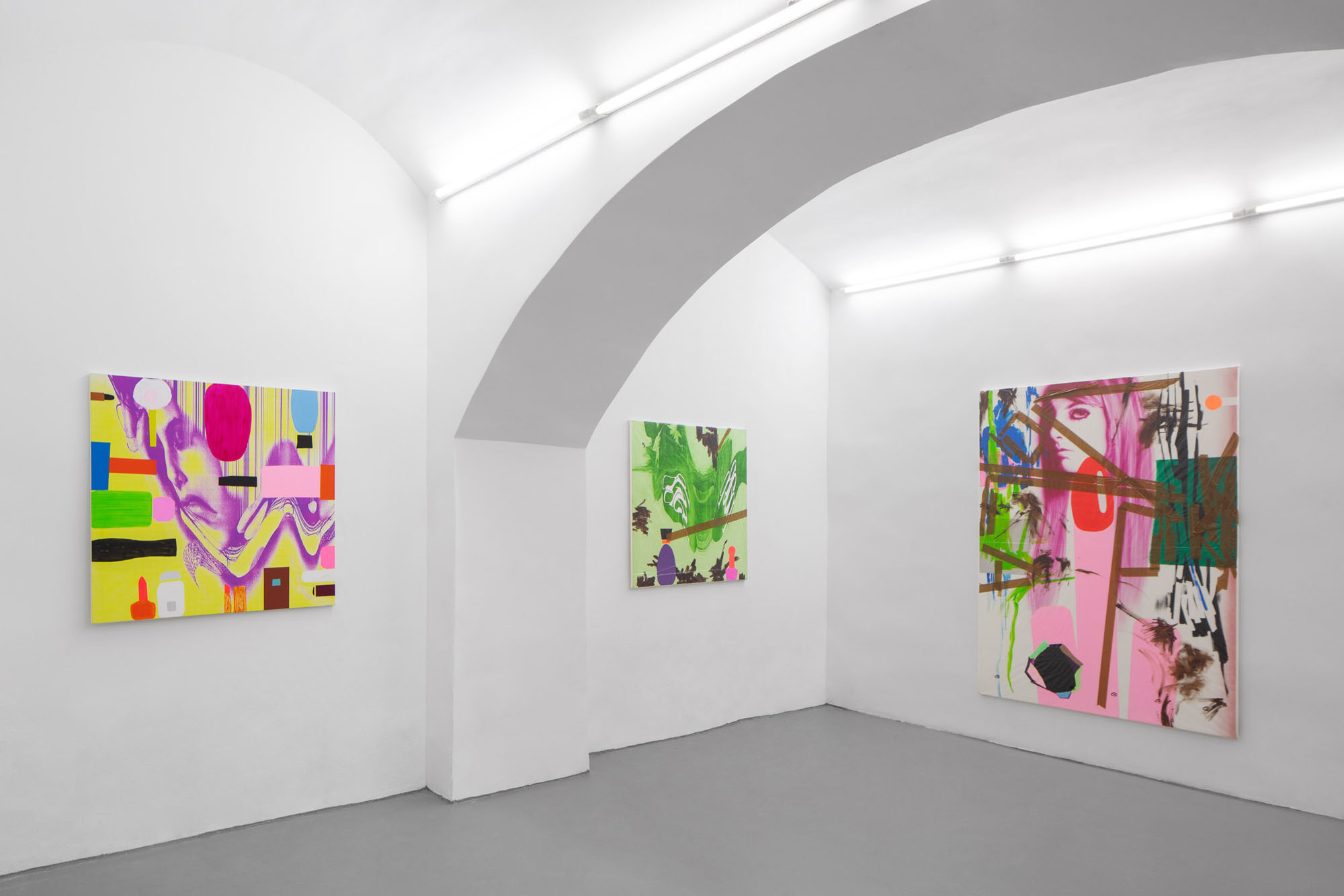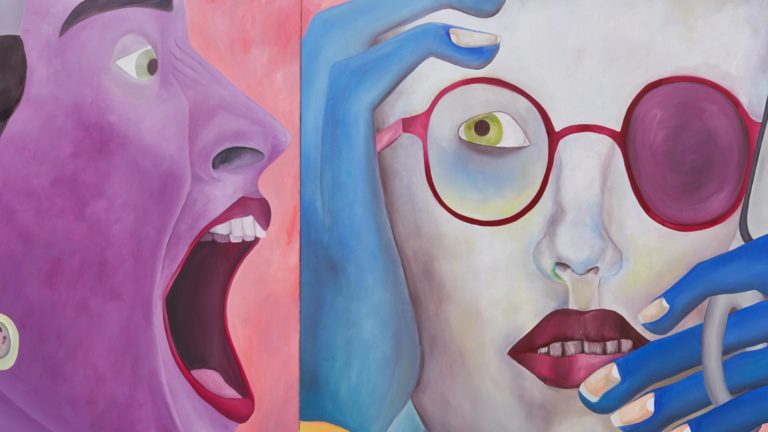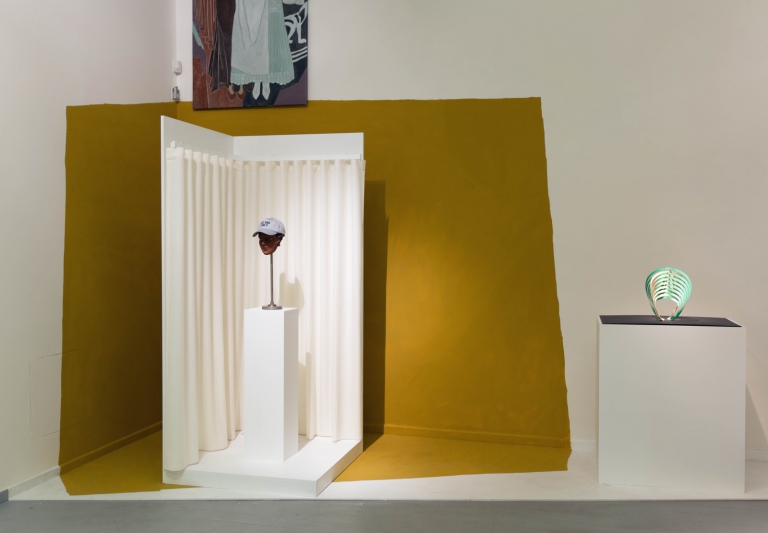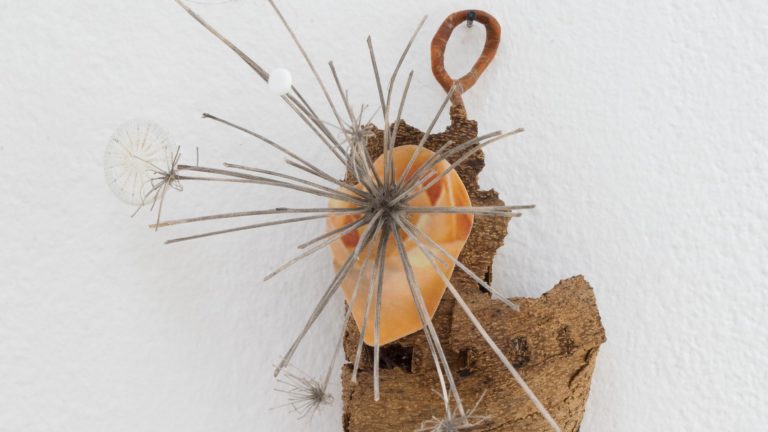Artist: Tomáš Lahoda
Exhibition title: Ad Paintings, Book Paintings, Genre Paintings, LaGuardia
Curated by: Michal Novotný and Lukas Hofmann
Venue: Futura, Prague, The Czech Republic
Date: September 25 – November 17, 2019
Photography: all images copyright and courtesy of the artist and Futura
While it has become uncontroversial, today, to refer to the ‘mass-media landscape’, even this term begins to appear increasingly romantic. In a time when information streams and echoes in such relentless volumes it seems almost impossible to isolate and situate its contents, like the estates and commodities scattered across the traditional painted landscape, in a space we can imagine entering. One we could step into, navigate, leave. Instead, a great texture of information coats the world around us like a second skin, which overflows and shifts even as we try to find a foothold, an edge to grasp or a thread to pull on – somewhere, anywhere, to begin.
In ‘The New Cosmogony’, the final part of Stanislaw Lem’s A Perfect Vacuum, a book that is composed as a series of reviews of imaginary books by fictional critics, the challenges of this ‘texture’ are enlarged to a cosmic scale. Lem, writing under the pseudonym Alfred Testa, describes a radically new model of the universe as a Game; one that is conducted by Players so advanced and so remote from one another that the only way they can hope to communicate is by making alterations to the laws of nature, and where each move of the Game consists of changing the rules themselves. Ultimately, the characteristics that allow the Players to perform these actions also separate them by such a vast divide that although they can affect the conditions of each other’s reality, they cannot learn of each other’s conscious existence, making any kind of dialogue impossible. Although ‘Cosmogony’frames this Game in the language of theoretical physics and the form of speculative fiction, the idea that the events of our daily lives, and even the material basis of our surroundings, arrive largely at the end of a chain of actions and choices by distant people we will never know, is hardly alien.
Lem’s central conviction, that control of the way information is received can communicate as much as, or even more than, what is actually said, is a pertinent one in the context of Tomáš Lahoda’s practice. His output, developed in series since the 1980s, has probed at the borders and overlaps between conceptualism, pop-culture, and mass media. Playfully mingling not only the visual languages of brand and commodity at a time when their acquisition could still be thought of as exotic, with the material practice of painting and its traditional modes, these large-format canvases invite us to consider the historical ebbs and flows of status these cultural elements connote, and the increasing collapse of difference that practices of re-combination have brought with them. It’s a long time since it has been particularly meaningful to talk about the appropriation of the ‘low’ into the ‘high’, particularly when the movement in the other direction has been so relentless. When fashion editorials started taking up position in front of esteemed paintings, is it any wonder artists themselves looked to advertising with a mixture of fascination and anxiety? Whether pop was an attempt to ingratiate or an attempt to quarantine this new culture once more within the framework of
art, the fragmentations, incorporation and diffusion that have followed have crowded our horizons so completely that these actions have become almost invisible today. This invisibility does not announce the triumph of pop so much as that of global branding and its totalizing influence; when we view pop now we see an image of newness that is firmly rooted in history, but its distance away from the spotlight of novelty may open up new possibilities of form, hidden within the texture.
Trapped between these endlessly reflecting surfaces, it may not be saying a great deal to suggest that Lem’s own exploration of weighty philosophical themes within the forms of genre fiction present a kind of mirror image to this. But although by no means his most significant work, A Perfect Vacuumrelates most directly to how we understand certain modes of conceptually-tinged artistic production, both in its overt self-reference and in the relatively limited scope of its targets and critical language. Lem is satirising not only the writers of books, but also the writers of the professional consumption of books, reviewers. In constantly alternating between genres of literary output and the genres of literary reception, this stubborn refusal to allow the reader to define any kind of stable agenda results in a text that not only can, but must be read from a range of positions, through a variety of eyes. This is perhaps Vacuum’s greatest achievement, and the one from which the most useful lessons may be learned. That its fragmentation of authorship, content and influence can allow us to view these categories more accessibly and appealingly than any amount of careful theory that debates this way or that whether a painting should be called an ‘object’ or a ‘text’. That there can be such a thing as a ‘sci-fi of criticism’, which uses the freedoms of its form to fully test the value of an otherwise impossible proposal, and lets us think through a set of parameters that are radically different, rather than ones that have merely grown over the bones of the familiar. Some contemporary art writing in this mode, like Katrina Palmer’s The Dark Object – where a student writes about her year in an art school that forbids the making of objects through a series of meditations and hallucinatory tutorials with philosophers both dead and alive, and where the memos between the school’s director and his secretary show increasing alarm that the accumulation of her texts might start to classify as an ‘object’ – supports this idea.
What connects Lahoda to the critical potential found in Lem’s writing is the careful adherence they both bring to form, since to accurately replicate not only seduces an audience to engage but also suggests, on reflection, an understanding of that form deep enough to contain a sort of implicit criticality – that the practitioner has lived behind the scenes and has seen up close where things are threadbare or held together with tape. Lahoda’s education was in the restoration of paintings rather than their ‘artistic’ production, partially for pragmatic reasons (since there is more of a market for touching up old things than there is for completely new ones), and partially to retain his independence outside the influences and agendas of the professors in the painting department. It is, after all, the particular ambiguity of criticism to try to see things from the inside and the outside at the same time, to live both in the wings and in the audience.
In the cross-section selected for this show, taken from Lahoda’s Book Paintings of the early 90s, following through the Genreand Adseries and culminating in the ongoing LaGuardia works, we are presented with the opportunity to look beyond the parameters that govern
their individual series and see the restless, questioning impulse that connects them. Still life, historically maligned as a bourgeois form of painting designed to replicate the act of possession, coexists in the gallery space with works that raise more contemporary questions of conspicuous consumption through the incorporation of distorted advertising images. Bright, graphic forms that speak of manufactured aspiration hang next to austere geometries, which, when they are recognised as fragments of vast airport space must also be recognised as being just as fabricated. That these most recent fragments are also the most unassuming seems to acknowledge the increasing dispersal of experience and collapse of certain types of border that is especially embodied in the tarmac of an airfield.
These paintings delight in the subjectivity and eclecticism of the mundane at the same time that they complicate certain assumptions of seriousness and value, and bring others down to earth entirely, pointing through the ways in which we all sift through overwhelming amount of information in the world around us. Like the moves by which Lem’s Players communicate but do not understand one another, this texture in which we exist is so inescapable, and its sources so numerous and inexplicable that it might as well be considered some sort of law of nature, one that it is up to us to signify for ourselves.
Lahoda’s practice engages directly with this arbitrariness, shifting constantly with the flow. In ‘God’, the earliest painting on display, the sentence formed by the spines of the books depicted quotes a Protestant saying: “God loveth adverbs; and careth not how good, but how well.” This proverb is usually taken to mean that the spirit in which something is undertaken is more important than its outcome. By its emphasis on the status of the adverb
– the quality that defines an action – ‘God’, and the works made after it, point to the message beyond what is written, where the form that conveys is more important than the immediate surface.
Text by Ari Níelsson

























